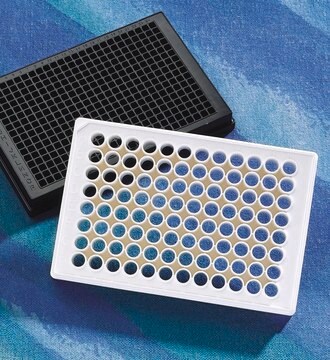P6403
Poli-D-lisina hydrobromide
suitable for cell culture, Mol wt 4,000-15,000
Sinónimos:
D-Lysine homopolymer hydrobromide
About This Item
Productos recomendados
product name
Poli-D-lisina hydrobromide, mol wt 4,000-15,000
form
powder or solid
Quality Level
mol wt
4,000-15,000
technique(s)
cell culture | mammalian: suitable
color
white to light yellow
storage temp.
−20°C
SMILES string
O=C(C)[C@@](NC)([H])CCCCN.[Br]
InChI
1S/C6H14N2O2.BrH/c7-4-2-1-3-5(8)6(9)10;/h5H,1-4,7-8H2,(H,9,10);1H
InChI key
MEXAGTSTSPYCEP-UHFFFAOYSA-N
¿Está buscando productos similares? Visita Guía de comparación de productos
Application
Este producto está recomendado como sustrato de cultivo celular cuando se utilizan entre 0,5 y 1,0 ml de una disolución 0,1 mg/ml para recubrir 25 cm2. Las versiones del producto de menor peso molecular son menos viscosas, pero las versiones de gran peso molecular proporcionan mas sitios de fijación por molécula.
Biochem/physiol Actions
Components
Caution
Preparation Note
Storage Class
11 - Combustible Solids
wgk_germany
WGK 3
flash_point_f
Not applicable
flash_point_c
Not applicable
ppe
Eyeshields, Gloves, type N95 (US)
Certificados de análisis (COA)
Busque Certificados de análisis (COA) introduciendo el número de lote del producto. Los números de lote se encuentran en la etiqueta del producto después de las palabras «Lot» o «Batch»
¿Ya tiene este producto?
Encuentre la documentación para los productos que ha comprado recientemente en la Biblioteca de documentos.
Los clientes también vieron
Artículos
Humankind has utilized protein materials throughout its existence, starting with the use of materials such as wool and silk for warmth and protection from the elements and continuing with the use of recombinant DNA techniques to synthesize proteins with unique and useful properties.
Nuestro equipo de científicos tiene experiencia en todas las áreas de investigación: Ciencias de la vida, Ciencia de los materiales, Síntesis química, Cromatografía, Analítica y muchas otras.
Póngase en contacto con el Servicio técnico





